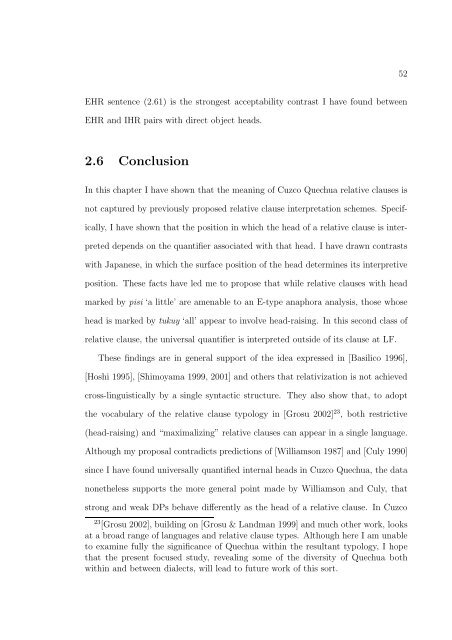the syntax and semantics of relativization and quantification
the syntax and semantics of relativization and quantification
the syntax and semantics of relativization and quantification
You also want an ePaper? Increase the reach of your titles
YUMPU automatically turns print PDFs into web optimized ePapers that Google loves.
52<br />
EHR sentence (2.61) is <strong>the</strong> strongest acceptability contrast I have found between<br />
EHR <strong>and</strong> IHR pairs with direct object heads.<br />
2.6 Conclusion<br />
In this chapter I have shown that <strong>the</strong> meaning <strong>of</strong> Cuzco Quechua relative clauses is<br />
not captured by previously proposed relative clause interpretation schemes. Specifically,<br />
I have shown that <strong>the</strong> position in which <strong>the</strong> head <strong>of</strong> a relative clause is interpreted<br />
depends on <strong>the</strong> quantifier associated with that head. I have drawn contrasts<br />
with Japanese, in which <strong>the</strong> surface position <strong>of</strong> <strong>the</strong> head determines its interpretive<br />
position. These facts have led me to propose that while relative clauses with head<br />
marked by pisi ‘a little’ are amenable to an E-type anaphora analysis, those whose<br />
head is marked by tukuy ‘all’ appear to involve head-raising. In this second class <strong>of</strong><br />
relative clause, <strong>the</strong> universal quantifier is interpreted outside <strong>of</strong> its clause at LF.<br />
These findings are in general support <strong>of</strong> <strong>the</strong> idea expressed in [Basilico 1996],<br />
[Hoshi 1995], [Shimoyama 1999, 2001] <strong>and</strong> o<strong>the</strong>rs that <strong>relativization</strong> is not achieved<br />
cross-linguistically by a single syntactic structure. They also show that, to adopt<br />
<strong>the</strong> vocabulary <strong>of</strong> <strong>the</strong> relative clause typology in [Grosu 2002] 23 , both restrictive<br />
(head-raising) <strong>and</strong> “maximalizing” relative clauses can appear in a single language.<br />
Although my proposal contradicts predictions <strong>of</strong> [Williamson 1987] <strong>and</strong> [Culy 1990]<br />
since I have found universally quantified internal heads in Cuzco Quechua, <strong>the</strong> data<br />
none<strong>the</strong>less supports <strong>the</strong> more general point made by Williamson <strong>and</strong> Culy, that<br />
strong <strong>and</strong> weak DPs behave differently as <strong>the</strong> head <strong>of</strong> a relative clause. In Cuzco<br />
23 [Grosu 2002], building on [Grosu & L<strong>and</strong>man 1999] <strong>and</strong> much o<strong>the</strong>r work, looks<br />
at a broad range <strong>of</strong> languages <strong>and</strong> relative clause types. Although here I am unable<br />
to examine fully <strong>the</strong> significance <strong>of</strong> Quechua within <strong>the</strong> resultant typology, I hope<br />
that <strong>the</strong> present focused study, revealing some <strong>of</strong> <strong>the</strong> diversity <strong>of</strong> Quechua both<br />
within <strong>and</strong> between dialects, will lead to future work <strong>of</strong> this sort.
















